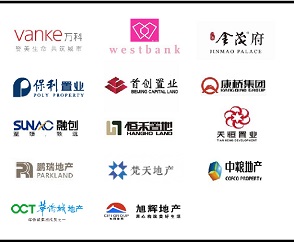瑞典米其林三星主厨餐厅
● 前言
PREFACE
全篇将以设计师“我”的口吻来记录瑞典餐厅上海店设计的心路历程,来揭露一家顶级的米其林三星主厨餐厅怎么样在与厨师和投资方的磨合中寻求设计的平衡,从而实现两地文化的碰撞进而迸发出新的火花。并以此来纪念这未被建成的项目。将来我们会以“遗失的米其林三星”为命名推出系列主题漫画,以更诙谐生动的形式讲述餐厅的设计理念以及厨师的经营理念,敬请期待。
The whole article will record the design process of Swedish restaurant Shanghai store in the tone of the designer "I", and reveal how a top Michelin three-star chef restaurant seeks a design balance in the run-in with chefs and investors, so as to achieve both. The collision of local cultures then burst out new sparks. And to commemorate this unfinished project. In the future, we will launch a series of themed comics named "The Lost Three Michelin Stars" to tell the restaurant's design concept and the chef's business philosophy in a more humorous and vivid way, so stay tuned.
● 瑞典
SWEDEN

“艺术给我们插上翅膀,把我们带到很远很远的地方。”——契诃夫
"Art gives us wings and takes us to places far, far away." - Chekhov
在我看来,北欧是全球最具有艺术气息的地方,没有之一。都说意大利是艺术之都,但我个人认为意大利更多的是“正统艺术”,它很“经典”,但也很“古板”。而北欧的艺术却更加前沿、诙谐、无拘无束,它是一种透在骨子里的艺术感,似乎并不是后天能够习得的。而在北欧中,相比于荷兰的自然、丹麦的童话、挪威的沉稳,瑞典设计更加张扬大胆:无论建筑还是室内,用色极其鲜亮明艳,形体往往有种幽默感。
In my opinion, Northern Europe is one of the most artistic places in the world. It is said that Italy is the capital of art, but I personally think that Italy is more of an "orthodox art", which is very "classic" but also very "old-fashioned". Nordic art, on the other hand, is more cutting-edge, humorous, and unrestrained. It is an artistic sense that is deep in one's bones and does not seem to be something that can be acquired. In Northern Europe, compared to the nature of the Netherlands, the fairy tales of Denmark, and the calmness of Norway, Swedish design is more bold and bold: both in architecture and interiors, the colors are extremely bright and bright, and the shapes often have a sense of humor .
● 选址
SITE SELECTION
投资方开始计划将餐厅开在上海外滩22号这座拥有百年历史的红砖老洋房,这栋建筑于2020年3月因大火关停修复,于2022年12月重新开业。投资方希望将瑞典餐厅作为首批开业餐厅进驻外滩22号,无奈历史保护建筑对于餐厅用火的限制实在太苛刻,尤其瑞典餐厅作为北欧料理对开放厨房的要求又是必备项。这对消防、食药监报批都造成极大困难。
无奈之下,只能转而寻找年限更新的建筑,最终把位置选在了中美金融信托大厦,地处“一江一河”交汇处的北苏州路,毗邻外白渡桥,中国邮政博物馆、上海大厦等历史保护建筑,坐拥上海最美河畔景观。
The investors began planning to open the restaurant in a century-old red brick bungalow at No. 22 on the Bund in Shanghai. The building was closed for restoration due to a fire in March 2020 and will reopen in December 2022. The investors hoped to open Swedish restaurant as one of the first restaurants to open at No. 22 on the Bund, but the historical protection building’s restrictions on the use of fire in the restaurant were too strict, especially as Swedish restaurant, as a Nordic cuisine, requires an open kitchen. This has caused great difficulties for both fire protection and food and drug administration.
In desperation, we could only look for a newer building, and finally chose the Sino-US Financial Trust Building. It is located on North Suzhou Road at the intersection of "One River and One River", adjacent to Waibaidu Bridge, China Post Museum, Shanghai Tower and other historical buildings. A protected building with the most beautiful riverside view in Shanghai.

▲上海外滩22号

▲上海中美金融信托大厦
● 风格
DESIGN STYLE
餐厅设计的第一原则当然是延续瑞典餐厅和瑞典基因,这也是主厨的强烈要求。瑞典餐厅现有几家门店设计(斯德哥尔摩、新加坡、伦敦)虽然延续了北欧特色,但我个人认为还是缺乏更令人印象深刻的亮点。投资方的观点是:在上海,纯粹的北欧风很难支撑起大几千的人均消费,它需要在原来基础上看起来更奢华一些。于是,我们思考或许可以将瑞典风格适当融入一些东方特色,既体现地域性同时增强空间的文化底蕴,也符合瑞典餐厅中西合璧的烹饪理念。但是“东”和“西”的结合会不会违和?原来,古人早已给了我们答案。
The first principle of restaurant design is of course to continue Swedish restaurant and Swedish genes, which is also the chef's strong request. Although the designs of several existing Swedish restaurant stores (Stockholm, Singapore, London) continue the Nordic characteristics, I personally think they still lack more impressive highlights. The investor's point of view is: In Shanghai, pure Nordic style can hardly support per capita consumption of several thousand, and it needs to look more luxurious on the original basis. Therefore, we thought that maybe we could appropriately incorporate Swedish style into some oriental features, which would not only reflect the regional identity while enhancing the cultural heritage of the space, but also be in line with Swedish restaurant’s culinary philosophy of combining Chinese and Western styles. But will the combination of "East" and "West" be inconsistent? It turns out that the ancients have already given us the answer.

▲明代时期【Chinoiserie】风格
灵感来自于:明朝时期洛可可与中国风糅杂,所形成的Chinoiserie风格。此外,我们还希望叠加时间的因素,从现代到古典,就像体验一场时代变迁的情景剧。这个想法源于瑞典餐厅所制定的用餐流程:1.入口接待以及食材展示;2.前餐区;3.主就餐区。他希望每一个流程都能给客人新的体验,所以每到一个区域都会用北欧特色的绒布帘把下个区域遮挡起来,整个用餐流程神秘又富有惊喜。
Inspired by: the Chinoiserie style formed by the mixture of Rococo and Chinese style during the Ming Dynasty. In addition, we also hope to superimpose the factor of time, from modern to classical, just like experiencing a melodrama of changing times. This idea originated from the dining process developed by Swedish restaurant: 1. Entrance reception and ingredient display; 2. Front dining area; 3. Main dining area. He hopes that every process can give guests a new experience, so every time he goes to an area, he will use Nordic-style velvet curtains to cover the next area. The entire dining process is mysterious and surprising.

▲硬装的时代变化

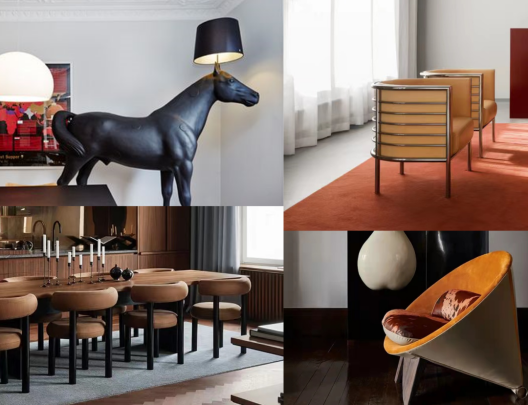
▲软装的风格混搭
于是,我们将整体的空间以时间分为三个阶段,每个阶段都代表了一个独特的文化融合:瑞典遇见上海,呈现了东方与北欧的交汇,北欧遇见南洋,展现了近代异域情调的融合,最后是西方遇见东方,将古典元素与现代风格交织。这种时间性的分隔为餐厅增添了深度和层次,让用餐者能够感受到不同历史时期的氛围,其中的形体构成均取自北欧传统风格,在不同的区域也有不同的主题色进行区分。
软装我们则希望采用不同时代、不同地域的风格混搭,以此来增添随性、居家的感受。
Therefore, we divided the overall space into three stages in time, each stage represents a unique cultural fusion: Sweden meets Shanghai, showing the intersection of the East and Northern Europe, and Northern Europe meets Nanyang, showing the fusion of modern exotic sentiments. , in the end, West meets East, intertwining classical elements with modern style. This temporal separation adds depth and layering to the restaurant, allowing diners to feel the atmosphere of different historical periods. The physical composition is taken from the traditional Nordic style, and different theme colors are used to distinguish different areas.
For soft furnishings, we hope to mix and match styles from different eras and regions to add a casual, homely feel.
● ● ●
瑞典遇见上海
SWEDEN MEETS SHANGHAI
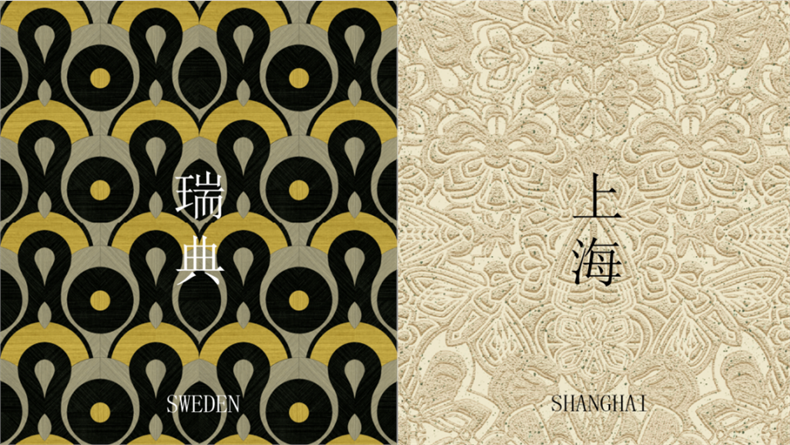
作为体验的第一步,“瑞典遇见上海”承载着食客对餐厅的第一印象,我们希望这个区域尽量还原原汁原味的瑞典特色。所以,这个区域的风格是最现代的。墙面上厚重的木构造型、色彩明艳的绒布帘、以及形态滑稽的前台桌都反应了当代瑞典元素。唯独具有老上海特色的花布台灯把人们的记忆瞬间拉回现实。
As the first step of the experience, "Sweden meets Shanghai" carries diners' first impression of the restaurant. We hope that this area will restore the original Swedish characteristics as much as possible. Therefore, the style of this area is the most modern. The heavy wooden structure on the wall, the brightly colored velvet curtains, and the funny-shaped front desk all reflect contemporary Swedish elements. Only the floral table lamp with the characteristics of old Shanghai brings people's memories back to reality instantly.
随着入口大门缓缓打开,一场滑稽荒诞情景剧上演了。会有接待人员帮忙存放好大衣,并建议用餐者先上个卫生间。因为每个区域都有拉帘隔开以保持神秘,开展参观后有中途离开便会破坏体验感。卫生间内部使用瑞典本土的带有植物纹样的布料作为壁布以及同款化妆凳,女士们开餐前可以先补个妆。
As the entrance door slowly opened, a comical and absurd melodrama was staged. There will be reception staff to help store coats and advise diners to use the bathroom first. Because each area is separated by a curtain to keep it mysterious, leaving midway after the tour will ruin the experience. The interior of the bathroom uses local Swedish fabrics with plant patterns as wall coverings and a makeup stool of the same style. Ladies can touch up their makeup before eating.

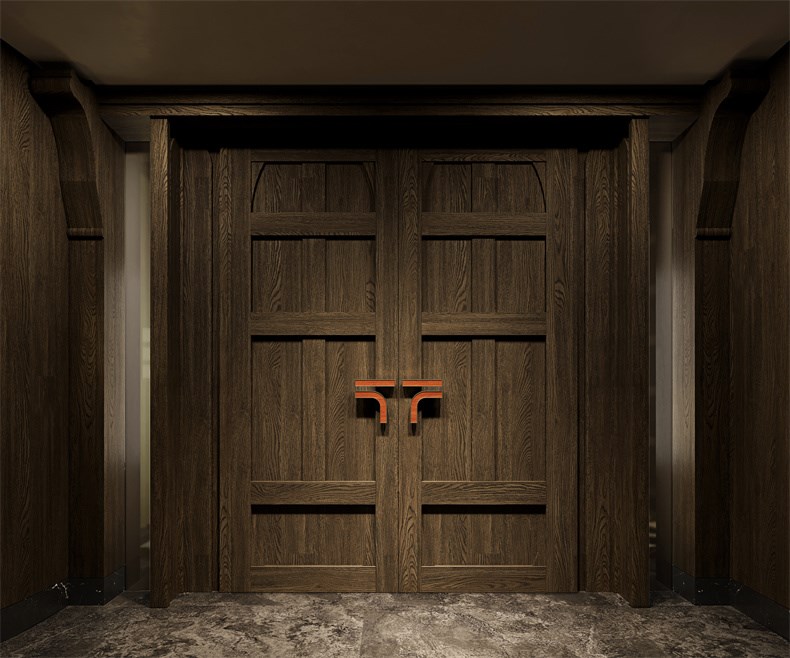

▲入口接待
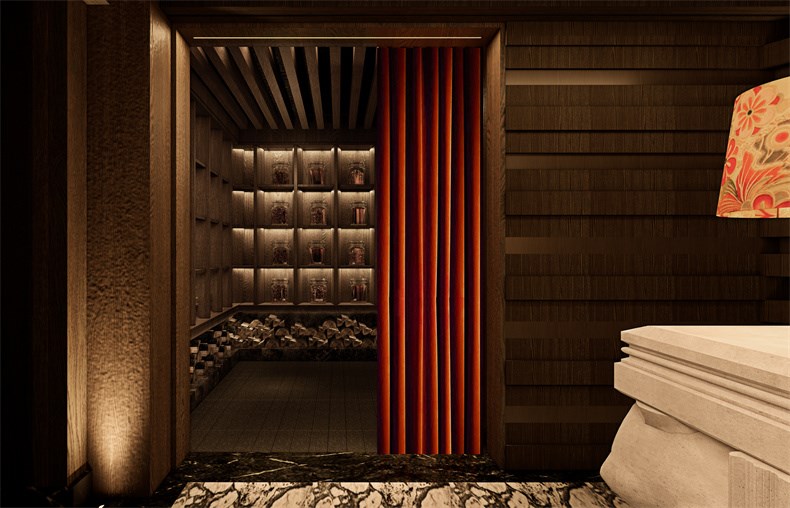


▲食材展示廊道
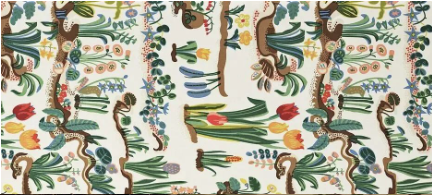

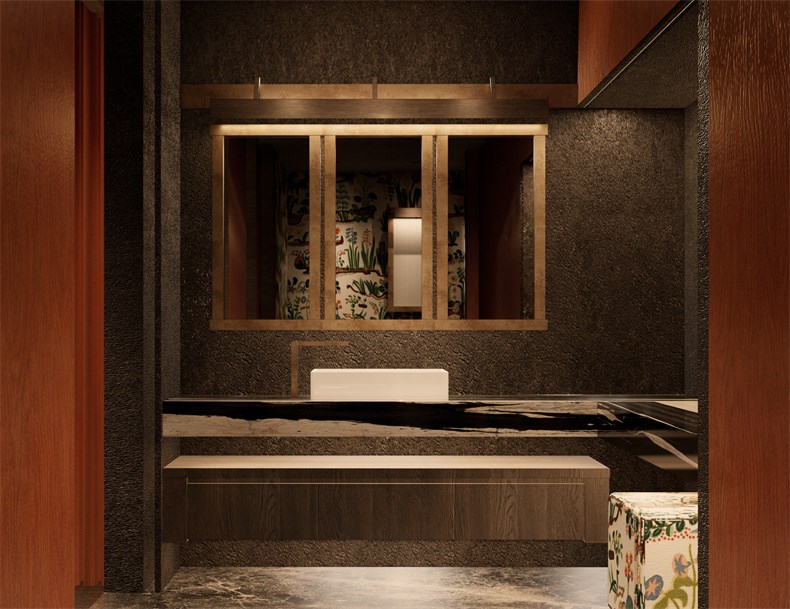
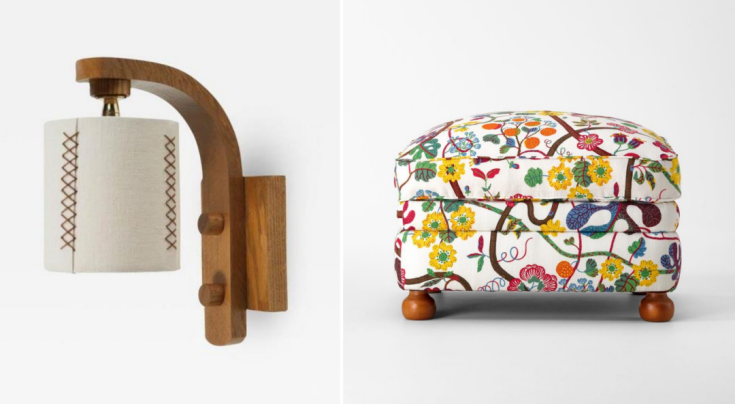
▲卫生间
拉开一道红色的布帘便来到食材展示区。墙面的排酸柜以及食材玻璃瓶展示了本季主要用到的食材原料。入口和走廊处均设计巧妙地运用了厚重宽大的木板,给人一种质感和稳定感。走廊右侧的排酸柜展现则体现了对食材质量的高标准和用心,使顾客在走廊中感受到餐厅对食材品质的专注,为整个用餐体验增加了期待感。
Open a red curtain and you will come to the food display area. The acid discharge cabinet and food glass bottles on the wall display the main food ingredients used this season. The design of the entrance and corridors cleverly uses thick and wide wooden boards to give a sense of texture and stability. The acid discharge cabinet display on the right side of the corridor reflects the high standards and dedication to the quality of the ingredients, allowing customers to feel the restaurant's focus on the quality of the ingredients in the corridor, adding a sense of expectation to the entire dining experience.
西方遇见东方
WESTERN MEETS EASTERN

从食材展示走廊出来左转就看到前餐区入口,厨师希望前餐区是客人休闲放松的场所,只是提供一些清酒和甜点。“西方遇见东方”表达的是古典元素的回归,我们认为古典元素更能表达休闲放松的气质。
Turn left after exiting the ingredient display corridor and you will see the entrance to the front dining area. The chef hopes that the front dining area will be a place for guests to relax and just provide some sake and desserts. "West meets East" expresses the return of classical elements. We believe that classical elements can better express the temperament of leisure and relaxation.
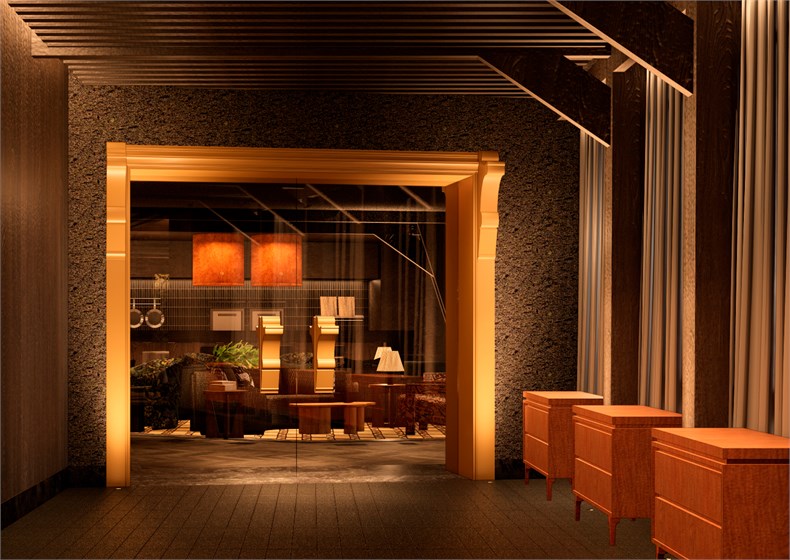
▲前餐区入口
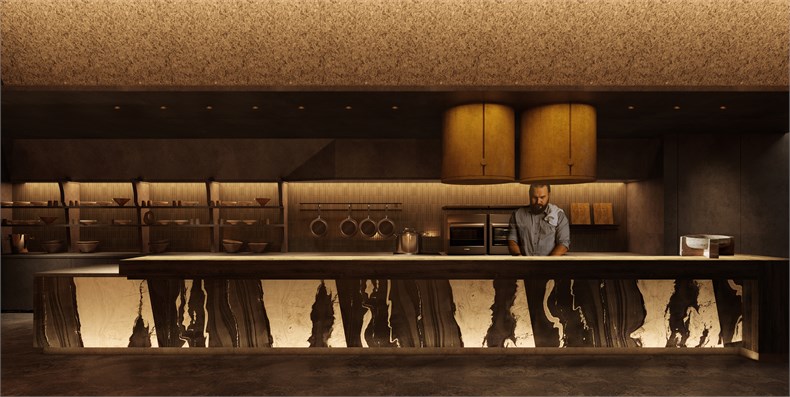
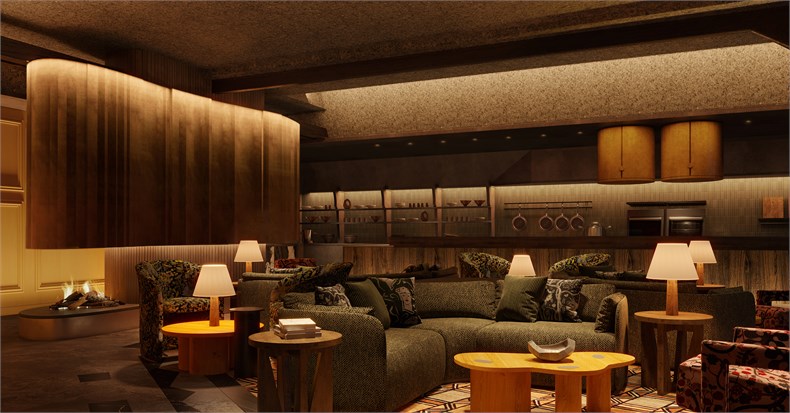
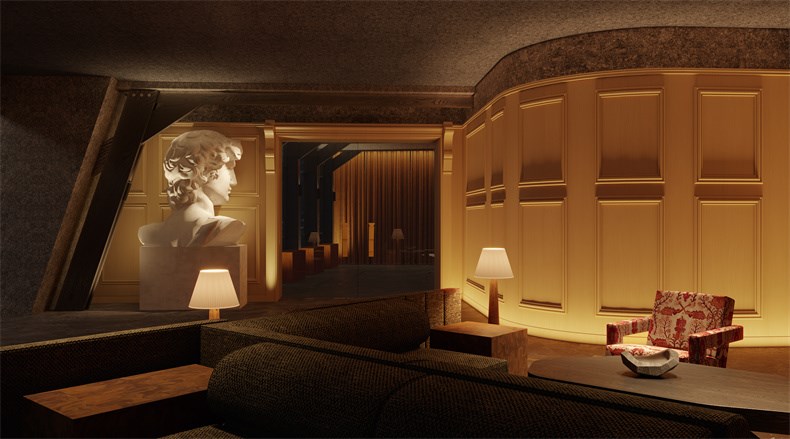


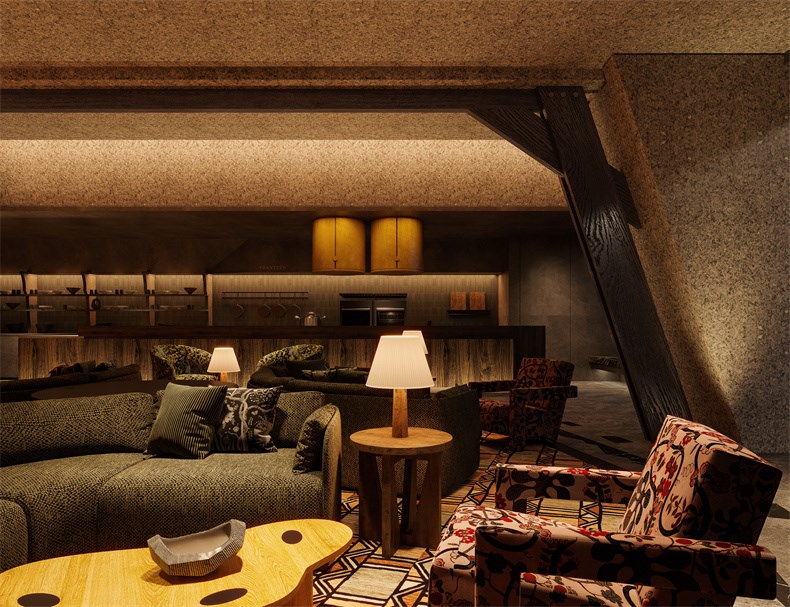
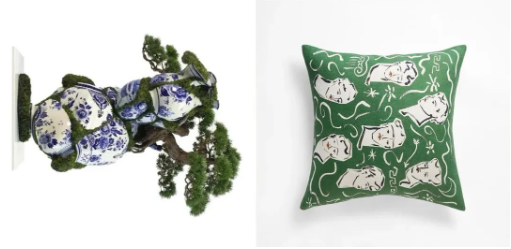
▲前餐区
前餐区,以黄色为主色调,复古的韵味尽显其中,休闲沙发、火炉等元素,强调家的氛围。开放式厨房让顾客能够近距离观察厨师的烹饪过程,增加互动性和参与感。布料选择上,我们精心挑选了带有鲜明当地特点的纹样,为空间增添了独一无二的氛围。为了确保纹样的原汁原味,我们特地与当地的布料商合作,以确保每一块布料都蕴含着地域的独特魅力。艺术品的选择,则是体现东方文化特点的瓷器、松柏。
The front dining area uses yellow as the main color, and the retro charm is fully displayed. Elements such as leisure sofas and stoves emphasize the atmosphere of home. The open kitchen allows customers to observe the chef's cooking process up close, increasing interactivity and participation. In terms of fabric selection, we carefully selected patterns with distinctive local characteristics, adding a unique atmosphere to the space. In order to ensure the authenticity of the patterns, we specially cooperate with local fabric merchants to ensure that each piece of fabric contains the unique charm of the region. The choice of artworks is porcelain and pine and cypress that reflect the characteristics of Eastern culture.
北欧遇见南洋
NORDIC MEETS NANYANG

享受完休闲惬意的前餐后就来到主就餐区,这里会庄重很多,是客人正式享受晚宴的地方。主厨要求开放厨房在整个区域的中心位置,所有的餐位都必须能看到开放厨房,一边享受美食的同时一边观看美食制作的过程是瑞典餐厅的特色。酒窖离开放厨房很近,方便厨师拿取酒水,也可以方便给客人展示新来的产品。
After enjoying the casual and comfortable pre-dinner, go to the main dining area, which is much more solemn and is the place where guests formally enjoy the dinner. The chef requires that the open kitchen be located in the center of the entire area, and all dining tables must be able to see the open kitchen. It is Swedish restaurant's specialty to enjoy the food while watching the process of making the food. The wine cellar is very close to the kitchen, making it convenient for the chef to get wine and to display new products to guests.
这个区域我们定义为“北欧遇见南洋”。它既没有前餐区那么古典放松,也没有接待区那么时尚现代,这里体现的是近代的美。我们用大量的倾斜梁柱木构件来体现传统的北欧建筑特色,包房的壁纸同样取自本土布料商。
We define this area as "Northern Europe meets Southern Ocean". It is neither as classical and relaxing as the front dining area, nor as fashionable and modern as the reception area. It embodies the beauty of modern times. We use a large number of inclined beams and columns to reflect the traditional Nordic architectural features. The wallpaper in the private room is also sourced from local fabric vendors.
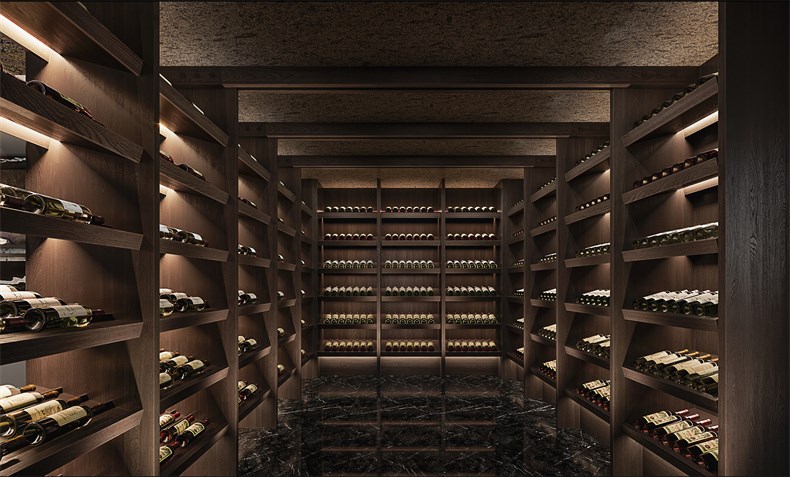
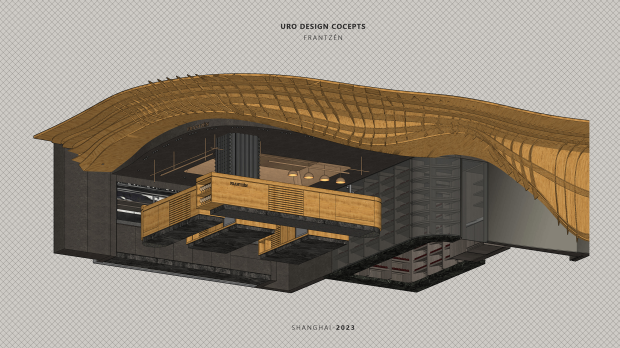
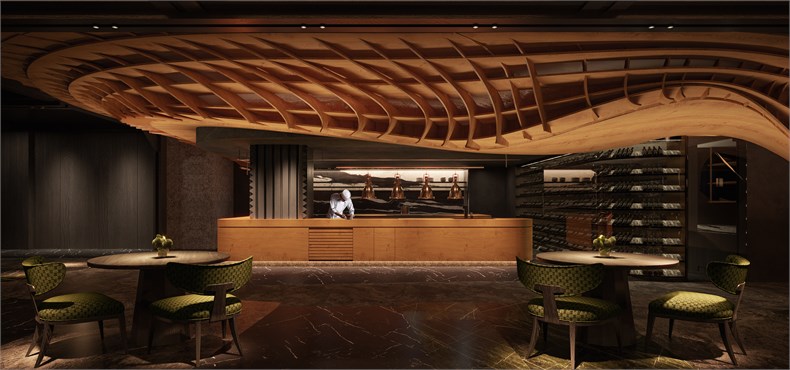

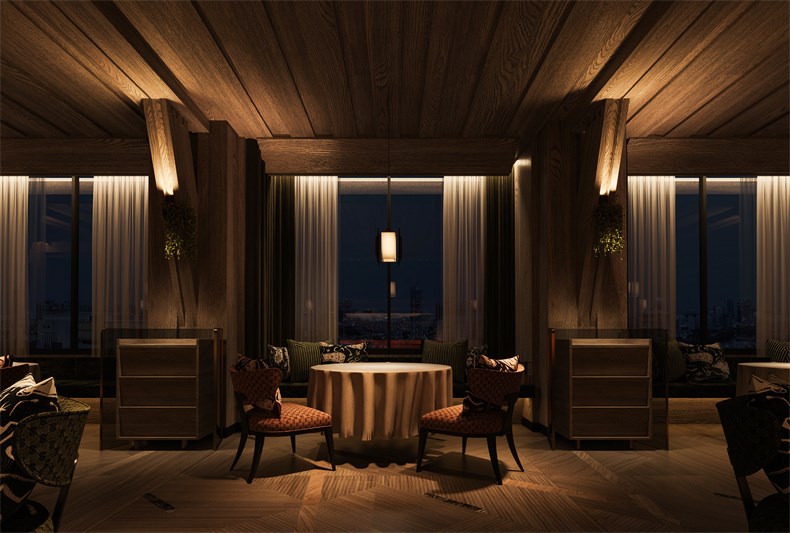
▲主就餐区
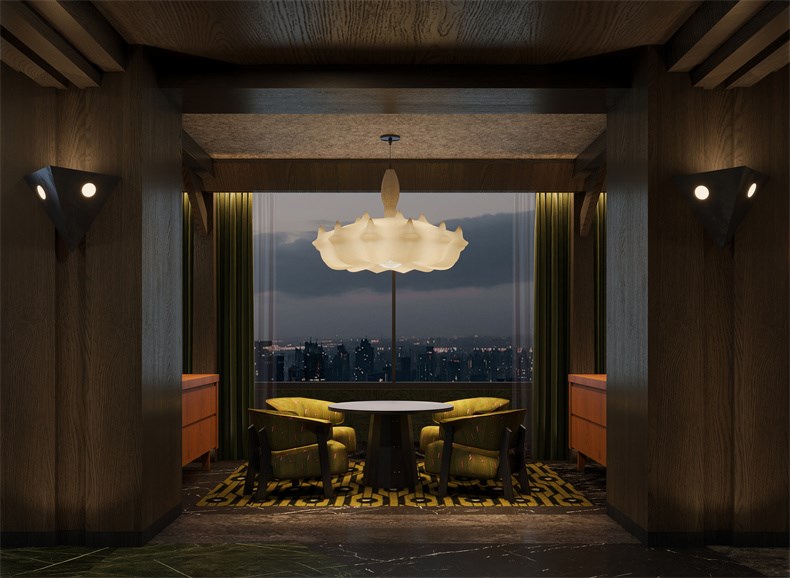
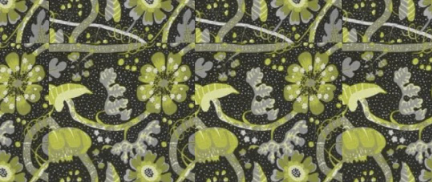
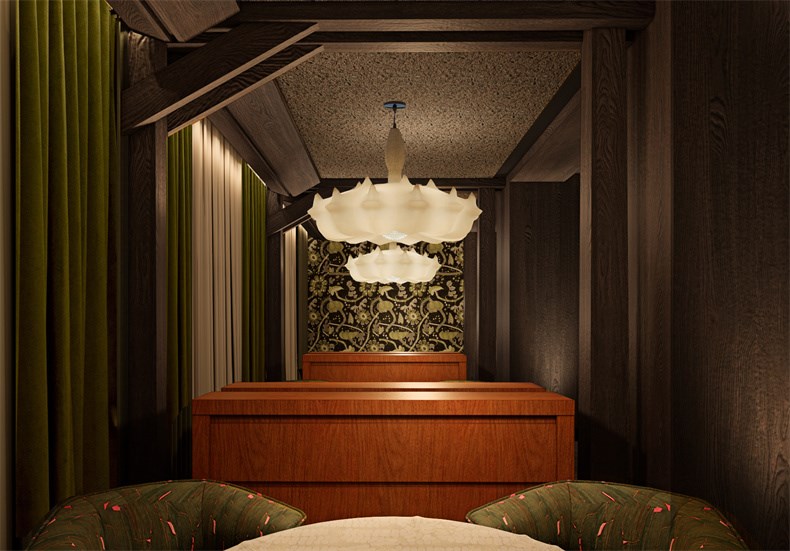
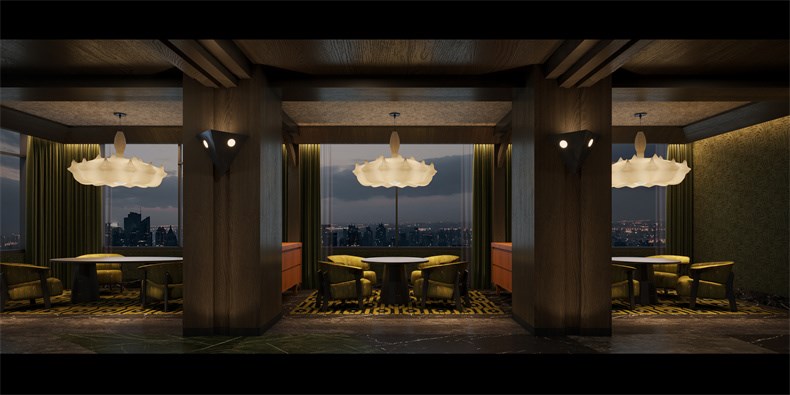
▲半开放包间
主就餐区还布置了三间半开放的小包房,而独特的绿色则成为主要的设计元素。我们使用了一种不骄不躁的绿色,没那么鲜亮却也不显暗淡。绿意渗透到整个空间,赋予了空间一种生机与活力,仿佛将用餐者带入了北欧郁郁葱葱的自然环境中。半开放的小包房为用餐者提供了一份私密感,可以在自己的空间中尽情享受美食,同时又能够感受到整个空间的活力和魅力。
The main dining area is also equipped with three semi-open small private rooms, and the unique green color becomes the main design element. We used a green that is neither arrogant nor arrogant, not so bright but not too dull. Greenery permeates the entire space, giving it a sense of vitality and energy, as if diners are brought into the lush natural environment of Northern Europe. The semi-open private room provides diners with a sense of privacy, allowing them to enjoy delicious food in their own space while feeling the energy and charm of the entire space.
▼平面图

项目名称 | 瑞典米其林三星主厨餐厅
Project Name | Swedish Michelin three-star chef restaurant
项目地点 | 上海
Project Location |Shanghai
主创设计 | 张颖
Principal Designer | Ying Zhang
设计团队 | 刘博、吴锦洲、吴俊、黄龙珠等
Design Team | Liu Bo, Wu Jinzhou, Wujun, Huang Longzhu
灯光设计 | 莫超
Lighting Design | Mo Chao
设计面积 | 796平方米
Design Area | 796㎡
URO DESIGN CONCEPTS 简介
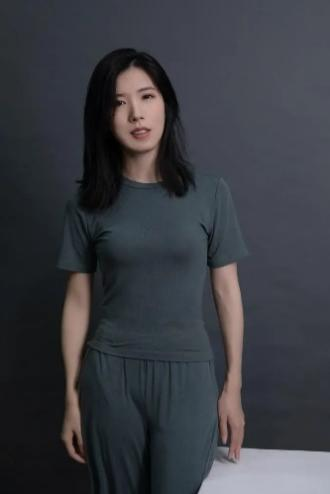
URO设计创始人 / 张颖 YING ZHANG
URO设计成立于 2016 年,由一群有着创意开阔思维的年轻设计团队组成。设计团队擅长从项目需求出发,建筑空间语言融入室内,研究具有实验性的空间设计,为业主提供富有创造力的空间解决方案。
URO设计创始人张颖,中国新生代建筑与室内设计师。曾就读于哈佛设计学院读建筑与城市设计,曾在世界知名建筑设计公司BIG、SOM工作,擅长研究空间形体与秩序,拥有多维度、多尺度的设计学术研究经历。将建筑空间语言融入室内,研究具有实验性的空间设计,尤其擅长运用曲线曲面造型塑造富有张力的空间语言。在商业、文化类项目中的实践,成功塑造多个具有识别性、前瞻性的空间形象。自2016年起已带领团队囊括多项国际顶级设计大奖。

设计腕儿官方微信
010-88600030

